Photo Record
Images
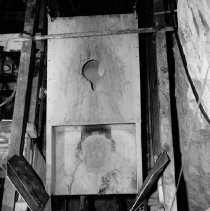
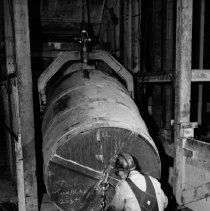
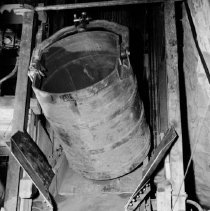
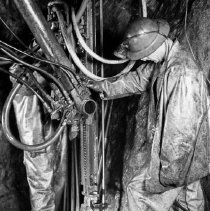
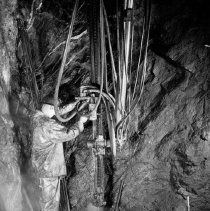
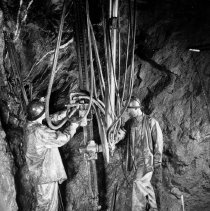
Additional Images [32]
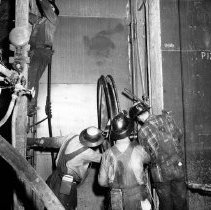
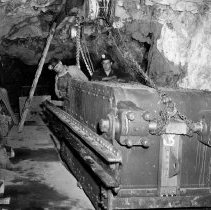
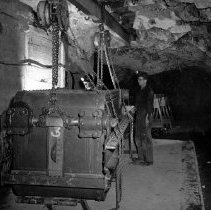
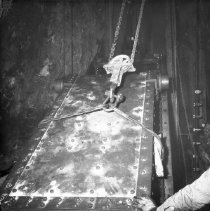
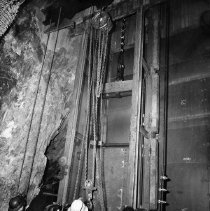
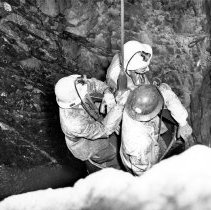
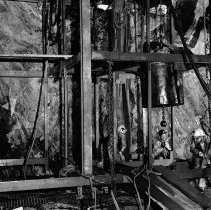
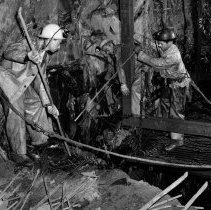
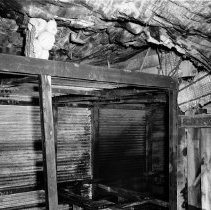
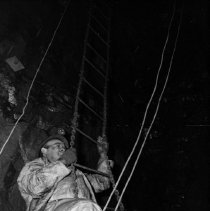
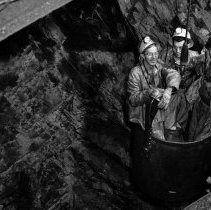
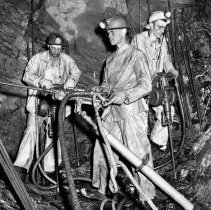
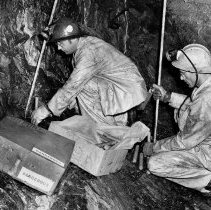
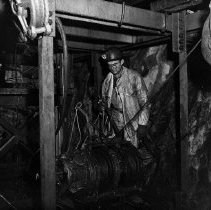
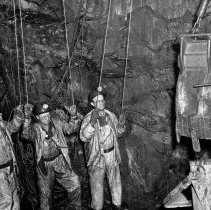
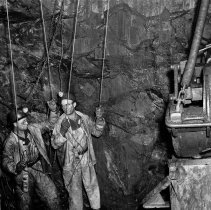
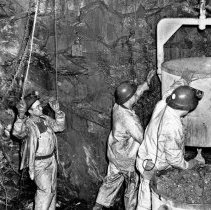
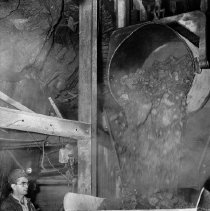
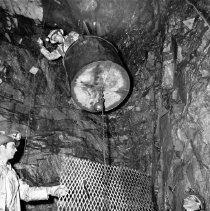
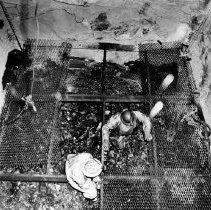
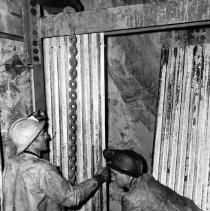
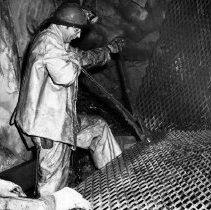
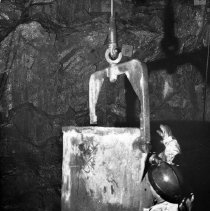
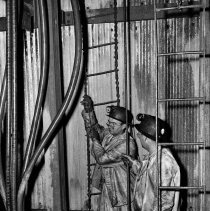
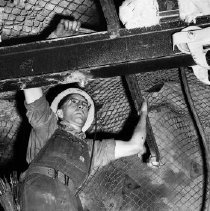
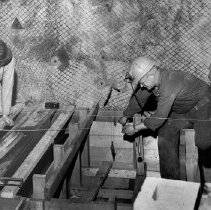
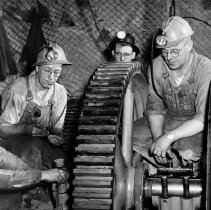
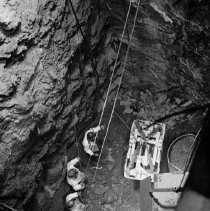
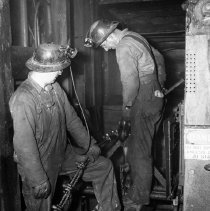
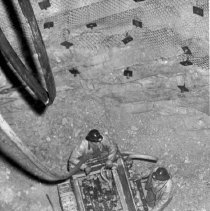
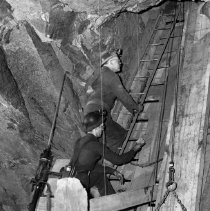
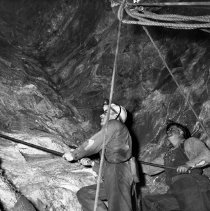
Metadata
Title |
WINZES, Winze #4 - Shaft |
Date |
1956-1963 |
Description |
Series of photographs of Winze #4 shaft. 518-1: View of part of the equipment in the Winze No. 4 shaft. 518-2: Unidentified man working on a barrel or possibly double drum. 518-3: View of the barrel or double drum. 518-4: Two unidentified men operating a drill. 518-5: Unidentified man operating a drill. 518-6: Two unidentified men operating a drill 50 feet below the 5,450 foot level, 1956. 518-8: Four unidentified men working on parts of the Winze No. 4. 518-9: Vic Mellini (left) and Winston Smith (right) assembling skips for Winze No. 4 on the 4,850 foot level. Sharp Bits, November 1962, Vol. 13, No. 5, pg. 8 "Final assembly of a skip for use in Winze No. 4 is being made by Vic Mellini (left) and Winston Smith. All parts were manufactured in the Mechanical Department shops and transported underground for assembly. Three skips were manufactured for this installation, two for operation and one fore a spare. All minor skip repairs will be made in this small repair area on the 4850-foot level." 518-10: Vic Mellini (left) and Winston Smith (right) assembling skips for Winze No. 4 on the 4,850 foot level. 518-11: View of a skip being hoisted. 518-12: At least six unidentified men standing around a hoist. 518-13: Three men checking for loose rocks as they are lowered to the bottom of Winze No. 4. Sharp Bits, December 1962, Vol. 13, No. 11, pg. 4 "Safety practice is important everywhere, and these shaft sinkers are checking for loose rocks as they are lowered to the bottom of Winze No. 4. Note water that has collected in the bottom of the shaft, deepest point of the mine. The water is an accumulation of shaft-guide lubrication and drilling practices." 518-14: Fred Olson (left), William Worsham (center, and Harold Bennett (right)setting shaft steel 5,600 feet below the surface in building the No. 4 Winze. Sharp Bits, November 1961, Vol. 13, No. 5, pg. 12 and 13. "This overall photo of the steel work that frames the shaft was taken from the 6,350-foot level station. Note the safety screen under the shaft steel; the bucket used for lowering and hoisting men and materials, and for hoisting broken rock. Putting the finishing touches on the steel set are Fred Olson (left), William Worsham (center) and Harold Bennet. 518-15: Harold Bennett (left), Fred Olson (middle), and William Worsham (right) install a shaft steel at the 6,350 ft. level. Sharp Bits, November 1961, Vol. 13, No. 5, pg. 11 "Closeup of shaft steel installation. This photo was taken from the 6,350-foot level station. Note the safety belts on the men and the safety ropes attached thereto. The safety screen supports Fred Olson and William Worsham (right), while Harold Bennett works from the corner of the station." 518-16: This picture shows concrete braces from shaft steel to solid rock. The muslin socks are filled with wet, freshly mixed cement and sand, and placed on the support which is made by bending reenforcing rod hooked over the H beam section of shaft steel. The rebars are then covered with wire screen to support the sacks. When the concrete sets a permanent brace is formed. The shaft steel is held in place by jacks until the concrete sets.;Illustration "I" Concrete braces in shaft Mining Section Newsletter April 1963 page 4 Sharp Bits, December 1962, Vol. 13, No. 11, pg. 12 "Featured here are sacks of concrete which brace the shaft steel sets to the solid rock. First, steel reinforcing bars are bent to shape, placed in the holes in the rock, and hooked to the shaft steel. Wire-mesh screen is then placed on the bars. Following this, muslin sacks, filled with freshly-mixed cement and sand, are stacked on these supports. A permanent bond is thus formed when the concrete sets." 518-17: Chain ladder into stope 1960sc; Miner going down a chain ladder into a stop where further work is being done, ca. 1960 Found on the cover of Sharp Bits, December 1962, Vol. 13, No. 11. 518-18: Freddie Olson (left), Harold Bennett (center), William Worshaw Riding in bucket, below the shaft steel, near bottom of shaft, 1962. Sharp Bits, December 1962, Vol. 13, No. 11, pg. 3 bottom "These men have a different ride to work than most of us. Riding the sinking bucket to the bottom of the underground shaft are Freddie Olson (left), Harold Bennett (center), and William Worsham." 518-19: William Mix, Marvin Ulmer, and John Budenberg are shown drilling in bottom of shaft. Sharp Bits, December 1962, Vol. 13, No. 11, pg. 5 "Starting to drill at the bottom of Winze No. 4. Note the weights hung on the drills operated by William Mix (left) and Marvin Ulmer (right). John Buddenberg is setting up to drill holes for rock bolts." 518-20: William Mix (left) and Marvin Ulmer (right) shown loading drill holes with dynamite. Sharp Bits, December 1962, Vol. 13, No. 11, pg. 6 "Loading holes. Following the drilling of holes, they are loaded with explosives. Doing this job approximately 6,400 feet below the surface are William Mix (left) and Marvin Ulmer." 518-21: Willie Burke inspecting double drum tugger which operates the placement of the clamshell on the muck pile during mucking operations. Sharp Bits, December 1962, Vol. 13, No. 11, pg. 7 "A double drum slusher hoist is important in this operation. It is located on the steel shaft sets above the open shaft. It provides the power for placing the clamshell bucket on the pile of blasted shaft-rock. Willie Burke is hooking up the cable controls which will allow it to be operated from the bottom of the shaft." 518-22: From left to right Kenneth Stevens, Orville Fritz, Willie Burke are operating the mucking equipment which includes the hydraulically operated clam shell and sinking bucket seen at the right. Sharp Bits, December 1962, Vol. 13, No. 11, pg. 8 "Precision teamwork is required here. Operation of the "mucking" equipment includes the hydraulically-operated clamshell and the sinking bucket. One man operates control that open and close the clamshell. A second man operates the "tugger" hoist that raises and lowers the clamshell. The third man operates the double drum slusher which moved the clamshell horizontally to any spot on the muck pile. Left to right are Kenneth Stevens, Orville Fritz, and William Burk." 518-23: From left to right Kenneth Stevens, Orville Fritz, Willie Burke are operating the mucking equipment. 518-24: Willie Burke, Kenneth Stevens, Orville Fritz lowering an empty sinking bucket is being lowered to the bottom of the shaft, after which the hoisting rope will be removed and placed on the full bucket to hoist it up while mucking continues. Sharp Bits, December 1962, Vol. 13, No. 11, pg. 9 "After an empty sinking bucket is lowered, the hoist tope is removed and placed on the full bucket in order to hoist it. Capacity of these buckets is 20 cubic feet." 518-25: George Maglike is shown taking care of dumping a bucket into a rocker dump car. Sharp Bits, December 1962, Vol. 13, No. 11, pg. 10 "Loads of waste from the shaft sinking operation are dumped on the 6,200-foot level. Dump operator is George Maglike. The cards of waste rock are then hoisted to the 5,900-foot level and dumped into the skip loading pocket." 518-26: Marvin Ulmer coming down in the bucket while William Mix and Arnold Kerber are holding a piece of safety screen which is being hoisted out because it is damaged. Sharp Bits, November 1961, Vol. 13, No. 5, pg. 14. "Take it up! Here a damaged section of safety screen is about to be hoisted. William Mix and Arnold Kerber steady the screen while Marvin Ulmer rides the bucket and signals the hoistman, whose hoist was 200 feet above this depth, as the time the photo was taken." 518-27: Marvin Ulmer and Arnold Kerber replacing damaged steel safety screens and thebottom Mine at the 6350 foot Level. Sharp Bits, December 1962, Vol. 13, No. 11, pg. 11 "The frame which supports the steel safety screen has been lowered to the bottom of the shaft to repair blasting damage. (Replacing damaged sections are Marvin Ulmer and Arnold Kerber). Note the chains at each corner which hold the screen under the shaft steel sets." 518-28: Marvin Ulmer (left) holds a sheet of lacing in place while Arnold Kerber (right) installs bolts to secure it. Sharp Bits, December 1962, Vol. 13, No. 11, pg. 13 (17) "Galvanized, corrugated metal sheeting called "lacing," is placed around the steel shaft sets to prevent any falling rock from entering the shaft compartments. Marvin Ulmer (left) holds a sheet of lacing in place while Arnold Kerber installs bolts to secure it." 518-29: Marvin Ulmer, William Mix, and Arnold Kerber repairing safety screen which has been damaged by blasting. This screen hangs under the steel shaft sets when the men are working on shaft steel. 518-30: Unidentified man in front of a bucket. 518-31: William Burke and Kenneth Stevens are being hoisted from the bottom of the shaft up to the shaft steel in sinking bucket. Stevens is holding on to the hoisting rope while Burke is pulling the signal rope which actuates a bell near the hoisting engine. Orville Fritz's head is just showing as he climbs up the manway. 518-35: Two unidentified men working in the Winze No. 4. 518-36: Four unidentified men working in the Winze No. 4. 518-37: Four unidentified men working in the Winze No. 4. 518-38: Three unidentified men operating the clamshell mucking equipment. 518-39: Two unidentified men working in the Winze No. 4. 518-40: Two unidentified men working in the Winze No. 4. 518-41: Robert Barker (top) and Jim Bauman (bottom) getting a line for driving rope raise out of hoist room on the 4,850 foot level. The raise is on a 60% incline. Sharp Bits, November 1961, Vol. 12, No. 10, pg. 6 "Getting a line for driving the rope raise out of the ore-hoist room on the 4850-foot level is Robert Barker (top) and James Baumann. The raise was driven on a 60 degree incline." 518-42: Marvin Ulmer (left) and Elwood Johnson (right) removing loose rock in the rope raise from the 4,850 foot level hoistroom the sheave wheel deck over the No. 4 Winze, 1961. Sharp Bits, June 1962, Vol. 13, No. 5 pg. 14. "Final bardown of all loose rock in the newly-mined-out rope raise from the 4850-foot level hoistroom to the sheave wheel deck over the No. 4 Winze was accomplished by Marvin Ulmer (left) and Elwood Johnson in mid-1961. This rope raise is 175-feet long by 14-feet by 13-feet and is at a 60 degree angle." |
Collection |
Homestake Mining Company Collection |
Object Name |
Series, Archival |
Catalog Number |
HMCC 518 |
Print size |
Please See Metadata for Print Sizes |
People |
Barker, Bob Bauman, Jim Bennet, Harold Budenberg, John Burke, Willie Fritz, Orville Johnson, Elwood Kerber, Arnold Maglike, George Mellini, Victor Mix, William Olson, Freddie Smith, Winston Stevens, Kenneth Ulmer, Marvin Worshaw, Wm. |
Search Terms |
1950s 1960s Drilling Explosives Hoists Homestake Employees Homestake Mining Company Men Miners Mining Mining Equipment Safety Safety in Homestake Sharp Bits |
